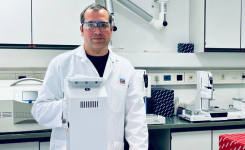Traditional methods of serological pipetting often demand constant attention to graduation marks and careful manual control, with risks of overfilling that can require filter changes. The PIPETBOY GENIUS offers a sophisticated solution for efficient, accurate serological pipetting in laboratory settings, addressing the limitations of conventional pipet controllers and streamlining liquid handling. It offers reproducible repeat dispensing from a single aspiration, features advanced overfill protection to minimize filter contamination, and has a Steady-Grip feature to reduce shaking of the pipet when moving between labware.
In this interview, INTEGRA Biosciences’ Christoph Philipp (Project Leader) and Marlene Frank (Product Manager) discuss the unique design features and capabilities of the PIPETBOY GENIUS, and explore how this innovative technology enhances pipetting efficiency and reliability.
Q: Tell us about the development of the new PIPETBOY GENIUS serological pipet controller.
Marlene: The idea of a new version of the PIPETBOY has been in the minds of INTEGRA’s team for quite a while. INTEGRA first brought the original PIPETBOY pipettor to the market 40 years ago and, at that time, it was a groundbreaking innovation as one of the first pipetting aids in Europe. However, since then, not much has changed in terms of serological pipetting technology, and customers have wanted functionalities like aliquoting or repeat dispensing built into their devices. We therefore began by conducting customer focus groups to gather insights, and much of that information directly influenced the PIPETBOY GENIUS’ development and priorities; customers should truly see their feedback reflected in the product.
Q: Describe the PIPETBOY GENIUS, its key features and how they benefit users.
Marlene: The PIPETBOY GENIUS is truly unique; no other device on the market offers this combination of features. One standout feature is the ability to perform repeat dispensing when used with INTEGRA serological pipets – dispensing multiple aliquots of the same volume from one aspiration – significantly streamlining workflows by eliminating the need to read the graduations on the pipet each time. This makes work faster, more efficient and more reproducible.
Another key feature is the overfill protection. Often, users accidentally overfill the pipet, which can disrupt their workflow. While the filter inside the pipet controller can be replaced, it’s an interruption. With overfill protection, users no longer need to worry about overfilling the pipet and can aspirate liquids more quickly. Additionally, we prioritized liquid level control, allowing precise control over dispensing to the very last drop, which is essential for many users.
Christoph: We also addressed user concerns about pipet stability. In the past, pipets could wobble when inserted, so we worked to improve stability, making the pipet insertion more secure. Customers also expressed a strong preference for a square-shaped handle, which helps them intuitively know the device's orientation without looking. Initially, we considered a more rounded, streamlined design, but the square shape was essential for user convenience, so we made sure to retain that feature. Additionally, customers often set the device down in various positions – even in ways that might not be intended – so we made sure it could be placed securely on any side. Ultimately, it was all about making the product more practical and comfortable for users who rely on it daily.
Q: What was the motivation behind designing the new controller and which challenges did you aim to address?
Marlene: Our aim was to address our customers’ need for aliquoting, as mentioned earlier. We also recognized that manually reading the graduation marks on the serological pipet is time consuming and tedious for many users. With the PIPETBOY GENIUS, we’ve introduced a completely new technology that removes the need to do this. While the exterior may look similar to other serological pipet controllers, the technology inside is entirely new and innovative, setting it apart from any other alternative on the market.
Christoph: As Marlene mentioned, every component inside the PIPETBOY GENIUS is different from previous or competitor models, making it a completely new product, even if the external shape is familiar. I like to compare it to the difference between an electric car and a car with a traditional combustion engine: they may look similar on the outside, but inside, they’re entirely different. It’s a reimagined design with cutting-edge technology, offering a completely different user experience.
Q: What challenges did the team encounter during development, and how did you overcome them?
Christoph: We encountered several technical challenges. First, achieving precise repeat dispensing was complex, due to the use of air displacement rather than a syringe. Unlike a syringe, which dispenses precise liquid amounts directly, our device uses an air pump to displace liquid at a distance, making accuracy challenging. Another issue was fitting all the necessary components into a compact design. The initial functional models were about 4 times the size of the final device, so we had to condense everything into a unit that was similar in size and weight to the original PIPETBOY controller, while significantly expanding its functionality. The third major challenge was ensuring component quality while managing costs. We needed durable, high quality parts to create a robust device that remained affordable for customers.
To address these challenges, we followed a rigorous development process. We started with early-stage prototypes to test technical feasibility and ensure that there was a demand for the features we envisioned among our customers. From there, we created functional models that showcased either the full device or specific components, allowing us to refine quality and understand the technical requirements better.
Each subsequent prototype brought us closer to the final product, allowing us to fine-tune components, system interfaces, and the overall integration of electronics, mechanics and firmware. In the final stages, we focused on industrializing the design, finalizing parts and setting quality standards for serial production. We then collaborated closely with our preferred suppliers to ensure we received high quality parts that met all of our design requirements.
Q: How does the PIPETBOY GENIUS pipet controller enhance accuracy, ease of use, reliability, etc. compared to alternatives?
Christoph: The PIPETBOY GENIUS introduces features that weren’t simply available in previous models, making it both safer and easier to use. It uses advanced, integrated electronics with all the necessary processors and sensors on a single circuit, including innovations like the pump. This pump, capable of delivering the required air volume, only became feasible with recent advancements in technology, making precise air displacement possible in such a compact device. These new technologies, combined with a talented development team, allowed us to address the physics challenges involved in creating a device that’s not only powerful, but also highly intuitive and feature rich.
Marlene: While there’s a lot of innovation in the PIPETBOY GENIUS, our primary motivation was to improve the user experience. We focused on making serological pipetting easier, more accurate and more reliable, so that users can work more efficiently and comfortably. All of the new features and technology are ultimately designed to enhance the customer’s workflow.
Q: Describe the testing and validation process for this product.
Christoph: This process involved rigorous, automated testing at every stage of development. We began using automated robotic systems to test the functional models or initial prototypes around the clock about 3 years ago, to verify they dispense precise amounts of liquid as intended.
In addition to overall functionality, we individually test each key component – such as valves, pumps and buttons – millions of times to confirm their quality and durability. This demanding component assessment occurs before the production phase to ensure reliability. After production, each device then undergoes another automated test to verify it meets all performance requirements – including dispensing accuracy – to confirm that it aligns with our standards. This ensures that every unit shipped performs to our exact specifications.
Q: How has this project informed or inspired future developments?
Christoph: This product has sparked numerous ideas for future R&D projects. As we developed this device, we explored a number of more advanced features, but consciously kept the design simple and familiar to ensure ease of use, especially given its evolution from our previous serological pipet controllers. We recognized that too drastic a shift might be challenging for users accustomed to traditional pipettors, and didn’t want to discourage adoption. Our aim going forward is to continually gather user feedback to understand how they interact with this new device. Over time, as customers become more comfortable with the technology, we’ll gradually explore integrating more advanced functionalities.
Marlene: We need to observe how user behavior evolves over the coming years. The PIPETBOY GENIUS opens up possibilities for controlling serological pipets in new ways and changes in usage patterns will give us direction for future improvements. On the other hand, if users continue using the controller as they currently do, we’ll likely maintain the design as it is, incorporating updates when demand calls for it. It’s really a constant review process; we don’t just release a product and leave it unchanged, and we’re always looking for ways to improve the user experience and expand its applications to help accelerate science.
About the Speakers


























